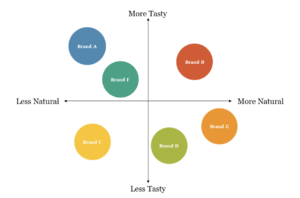Better Marketing
Blue Ocean Strategy and Positioning in Business
When does Brand Positioning become Blue Ocean Strategy?
Competition is fierce and getting worse. You keep working to improve, but it’s almost impossible to get ahead. What do you do?
Do you keep bashing away trying to find a tiny, elusive competitive edge that might evaporate any day, or do you decide to zig while the competition is busy zagging!
That’s essentially what this post is about. It’s a big topic that could affect not just the direction of your marketing, but your whole business! Whilst we’ve written about brand positioning already, this post takes an even broader view. So just a quick recap to begin with…
What is Brand Positioning (and how do I get one)?
It’s when you analyse the market, your customer needs, your competitors and the essence of your business (or service or product) – and find a match between what you can legitimately offer, that hopefully nobody else can, that your target market actually cares about.
This helps differentiate your product or service from everyone else, leading to an increase in marketing effectiveness, sales, market share, profitability and customer retention.
It’s a necessary basis for growing your business, and yet a surprising amount of companies never even look at it. Perhaps that’s why, if you do spend some time on a well thought-out brand positioning, followed by a cohesive marketing strategy, you’ll find that your message will start to resonate with the people you hope to help.
All of that, in fact, is what we do for a living, for a variety of SMEs, mainly in the B2B space. With a lot of success.
Want to get started on a brand positioning right now? Here are the four key steps in summary …
- Analyse your customers
Find out what they truly care about, and what they really need. You can often find relevant market research online, or even…. ask your customers!
- Examine your offering
Write down all the attributes you offer that are most desirable to your target market. (Hint, be ready to substantiate your claims in your marketing so pick real attributes, not ones you wish you offered!)
3. Map yourself against your competitors
Draw XY axes and place your attributes on them along with their opposite like the simple example below. Add yourself and your competitors and note the relative positions and how crowded your space is. Try remapping with different attributes along the axis until you find a space that you can genuinely offer, that your customers actually care about, that few others offer.

When positioning looks kinda blue….
Sometimes, however, the research and thinking that goes into determining a competitive positioning leads you to sail into a whole new vista of uncharted possibilities opening up before you.
Or indeed, you might simply decide that brand positioning isn’t quite enough and you’re determined to head into the wild blue yonder to do what nobody else does, and go where nobody has been before.
Either way, you’re heading into what’s known as ‘Blue Ocean’ which can be terribly exciting as it opens up new opportunities, and a little bit daunting at the same time.
I say this from personal experience, because it we went through it ourselves quite recently.
But before we get into that story, let’s describe what a Blue Ocean Strategy is…
What is Blue Ocean Strategy?
The term was coined by W. Chan Kim and Renee Mauborgne, who launched a book of the same name in 2004. Based on a study of 150 strategic business moves, spanning over 100 years and 30 industries, the two INSEAD Business School Professors came to the conclusion that…
“…tomorrow’s leading companies will succeed not by battling competitors (in a bloody ‘red ocean’ of rivals fighting in a shrinking profit pool) but by creating ‘blue oceans’ of uncontested market space ripe for growth.”
In other words, doing something nobody else has done before – and creating a market that literally didn’t exist before.
No mean feat, dear reader, yet their research fully supports the claim. Now we’re not going to cover the entirety of a 190 page book right now, but if you really want to get into it, you can buy a copy here – enjoy.
So, what’s the difference between Brand Positioning and Blue Ocean Strategy?
Brand positioning concerns the way you present your brand to your existing target market vs your competitive brands, while a Blue Ocean Strategy goes beyond brand to a whole-of-business approach and might even require the development of a completely new product or service, the opening of a new distribution channel, potentially the launch of a new brand, or at least the creation of a new business unit.
So if you set your course on a Blue Ocean Strategy, prepare for a major voyage!
Blue Ocean success stories
One of the best examples, indeed the first example that’s covered in the book, is that of Cirque de Soleil. Now if you’re old enough to remember, and unfortunately we are, you can cast your mind back to the pre-80’s when the circus industry was dominated by Ringling Bros. and Barnum & Bailey-style ‘Greatest Show on Earth’ featured the classic three ring circus with performing animals, acrobats and clowns. Problem was, with increasing entertainment options available, and creating an appetite for a more visually rich kind of experience, a family trip to the circus was fading in popularity.
Enter stage right, a Montreal street performer called Guy Laliberté who decided to turn the entire concept on its head. He got rid of the animals, reduced the number of rings to one, and repackaged the circus as a high end, theatrical entertainment offering for adults.
The result? Launching in 1984, Cirque de Soleil expanded rapidly from one, to 19 shows in over 300 cities. By 2017, the business employed 4,900 people from 50 countries, and generated an annual revenue of US$1 billion rendering the ‘competition’ irrelevant, creating a whole new market, and reaping the benefits.
Netflix did the same with streaming, as did Apple when they launched the iPod and the iPhone. (Don’t think Apple’s a B to B brand? I’m writing this on an iMac while I juggle work calls on my iPhone!).
How InsideOut Group emerged from our own Blue Ocean Strategy
OK, so we’re no Netflix but we’ve been helping SMEs grow for over 21 years now (under our former name, Permission), and a couple of years ago we took a step back, and had a strategic look at the market.
Marketing agencies are a dime-a-dozen and we needed to find some clear space. Initially, we thought we might reposition our brand to talk specifically SMEs in the B2B space (our core passion and skillset), however when we examined our customers, perhaps in greater depth than ever before, we realised a greater shift was required.
The eternal problem for SMEs, we realised, was they needed senior marketing support inside the business, to make a real difference to their growth trajectory – yet unfortunately, most of them couldn’t afford it.
Our ‘aha’ moment, if you will, was to place senior marketers inside SMEs part time (making them more affordable) who are also supported by our services team in the background. As far as we could see, nobody else was doing this, so we decided to dip our toes in the water for a while to test the idea; we invested the minimum amount we could to get the idea off the ground in a beta (basic trial) format – and the response was extremely favourable.
So we bit the bullet – we restructured, renamed, repositioned and relaunched the business around this very idea, and here we are today, growing into a new space we created. Now there may be another company out there offering this kind of service on the side (let’s face it, we haven’t invented the iPad here) but so far as we’re aware nobody has built their business specifically around the model.
How you can get there yourself…

It’s not often we use ourselves as a case study, but to be honest – no offence – we’re probably a lot more relevant to your business than Apple or Cirque de Soleil.
So how did we find our own Blue Ocean Strategy? Well, we started with a deep dive into the needs and wants of our customers, before analysing the competitive landscape and putting it all together from there. And to be honest, not having a budget for extensive market research, a big part of that deep dive was the 20-odd years of being in business.
Of course there are ways to shortcut this, and guidelines with practical steps you can take. Our two Professor friends have put a succinct, five step process together, as outlined below.
- Get Started.
Choose the right place to start your blue ocean initiative
- Understand where you are now
Get clear on the current state of play
- Imagine where you could be
Uncover the hidden pain points imposed by your industry
- Find out how to get there
Reconstruct market boundaries
- Make your move
Select and rapidly test your blue ocean move.
Formalize your big-picture business model and launch your move.
Brand positioning or blue ocean?
To summarise the difference, you should ask yourself this difficult question: do you want to get smarter about dealing with your competition, or do you want to take the chance search for a whole new area to play in?
The first – a brand positioning – is the first port of call for most organisations in most situations, and it can be transformative in its own right.
But if you decide to seek clear water, be prepared to make fundamental changes of all sorts that go well beyond brand and marketing. In the end, there are probably lots of ways to find your own Blue Oceans and if you keep an open mind, and try to look at your market, customers and competitors from a different perspective now and again, with determination and courage you might just change your destiny.
We’d be more than happy to talk about Blue Oceans or, in the meantime, we can help you with brand positioning, a cohesive strategy and even a part time senior marketer to make it all happen. Just contact us here and let us know.



